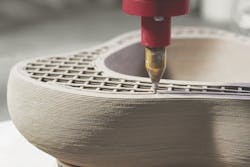3D Printing Meets Bath Design: Kohler Rock.01 Sink
3D printing technology is creating a bigger and bigger footprint in residential construction. Recently, 3D off-site construction company ICON announced the creation of the world’s largest 3D-printed community with Lennar this year. Grand View Research forecasts a 91% increase in the global 3D construction market, and now, once again, the technology emerges in bathroom product manufacturing, but this time, through ceramics.
Kohler Rock.01
Kohler debuted Rock.01, a 3D-printed bathroom sink, at Design Miami/ 2021. Designed by contemporary artist Daniel Arsham, just 99 of these cutting-edge sinks were available to purchase in December (and sold out in 30 minutes).
3D-printed products are nothing new, but this marks the first washbasin from a national kitchen and bath manufacturer through its own ceramic 3D printing technology. 3D printing had its first patent in 1980, became commercially available in 2008, and now there are hundreds of 3D printer manufacturers across the globe since that patent expired.
Kohler’s first go with 3D manufacturing was in 2018 with its design-centered brand Kallista and the Grid faucet. Since that first success of stainless steel metal printing, Kohler’s team of vitreous engineers and operations worked on creating and perfecting a new ceramic 3D printing technology, which faced a critically different set of challenges.
“You think about how much [the clay] has to build on top of itself and build up, and how soft that clay is, so the experts thought it wasn’t possible because any known formulation would fall into itself on that scale,” says Erin Lilly, Kohler design studio manager.
Rock.01 is printed from vitreous china clay in 3D printing’s typical layer-by-layer fashion over 7.5 hours, then glazed to be given the hygienic, glass-like surface. The company says the printing process mirrors the traditional coil-building technique where ceramicists hand build pottery by layering hand-rolled coils of clay.
The result is an organically shaped body that’s then laid atop a brass “rock.” This rock comes from a 3D-printed mold that craftspersons hand-pour brass into and then hand cast each piece. The two forms mimic how one may see two rock formations in nature, juxtaposed by the high-tech creation process.
Additive manufacturing coincides with Kohler’s principles of sustainability and innovation, says Lilly. The process of casting vitreous china creates lots of waste, but this eliminates much of the waste from production.
“We’re just seeing the beginnings of additive manufacturing for vitreous production,” says Lilly. “We’re going to continue to advance not only the chemistry of the body but the engineering of the process itself. It’s not like we’re going to be 3D printing toilets in the next year, this is still something that’s highly artistic, and very much in true Kohler fashion, we’re taking something that’s beautiful and an art form in itself and bringing it into the building products space.”
RELATED: 3D-Printed Community


